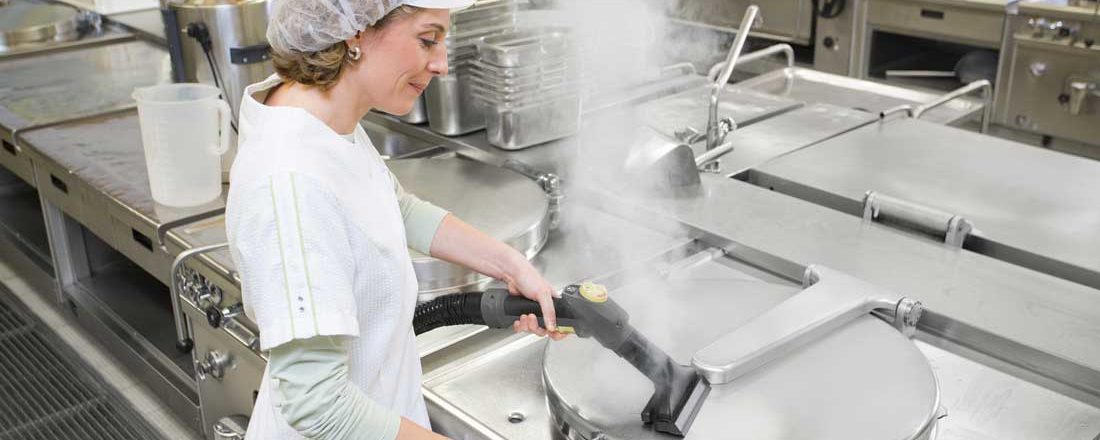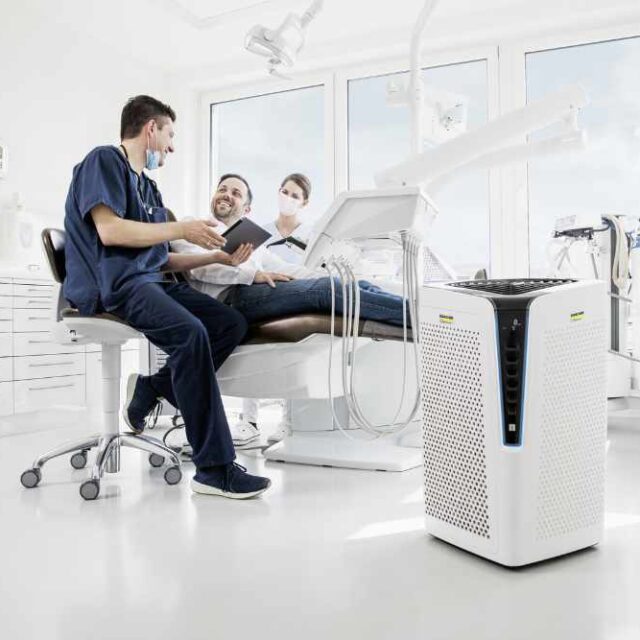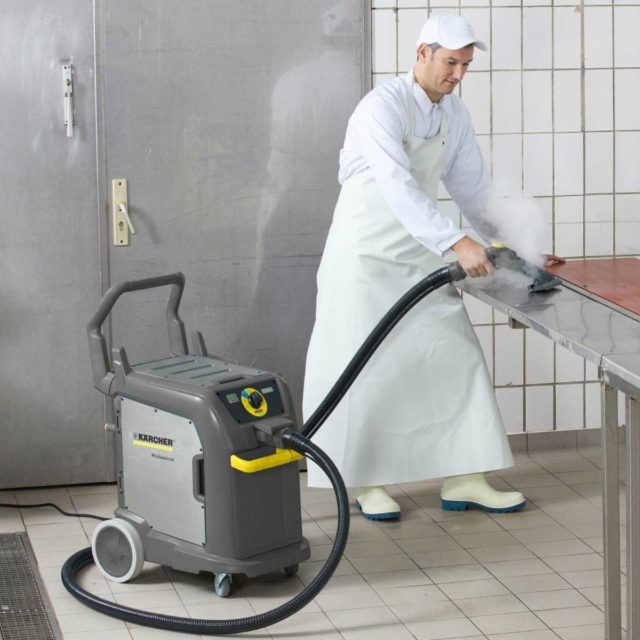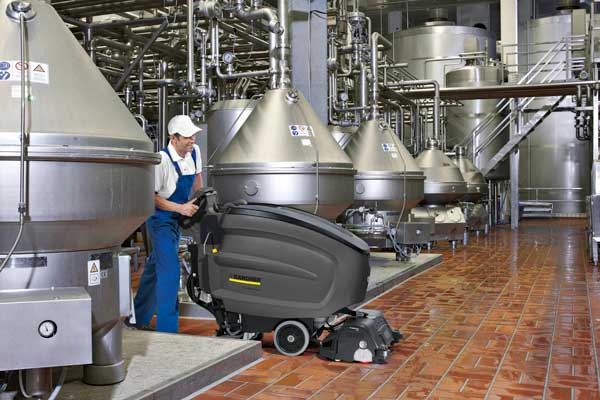One of the most vital considerations of running a food business is cleanliness and hygiene. If a company fails to take food hygiene into account, not only could it lose its Food Hygiene Rating and reputation, it also runs the risk of making customers seriously ill.
We have covered the need for cleaning catering equipment, now here’s our guide to cleaning food preparation areas and keeping customers and operators safe.
This guide covers the government guidelines on food hygiene, preventing cross contamination, cleaning food preparation surfaces, eradicating pests, introducing deep cleaning to the kitchen, examining the invisible hazards of bacteria and viruses and the benefits of steam cleaning.
In short, everything you need to know to keep your food preparation areas clean, hygienic and minimising the risks to workers and customers. And if you find us repeating the words ‘detergent’ and ‘disinfectant’ a lot, it’s because they are pretty important aspects of cleaning food preparation areas in any kitchen environment.
Food Standards: Your Legal Requirement
There are three potential hazards in a kitchen; the physical obstructions and dangers, like slips and trips, manual handling, poor storage and the danger posed by fire and electrical safety; chemical hazards, and; microbiological hazard. All of which are important safety considerations for a kitchen environment.
But, according to The Food Standards Agency, ‘not cleaning thoroughly is one of the most common reasons why food businesses are prosecuted’, and they are pretty clear in their guidance for cleaning and maintaining food preparation surfaces through the use of detergents and disinfectants. The guidelines here seek to reduce the pest, chemical and microbiological hazards when cleaning food preparation areas.
There are five strict guidelines a kitchen must operate under:
– Clean and disinfect between tasks
– Clean as you go
– Use disinfection products that adhere to either BS EN 1276 or BS EN 13697.
– Dispose of food waste suitably.
– Operate a strict cleaning schedule.
The advice is to always use detergents to clean surfaces of grease and visible dirt. And always follow with disinfectants that can then be used to kill any bacteria, but remember they are less effective on visibly dirty or grimy surfaces if used before cleaning with detergents.
Eradicating Pests from the Kitchen
Pests such as mice and cockroaches can wreak havoc on a business and so it’s vital that you keep your premises clean and avoid doing anything that could encourage their presence.
One of the most common causes of a pest problem is when a business fails to clean the kitchen floor effectively. It is vital that all kitchens:
– Immediately clear up any crumbs or spills from floors, work surfaces and shelves
– Store foods in airtight containers
– Dispose of garbage regularly
– Eliminate all moisture sites, including leaking pipes and clogged drains.
So operators should make a habit of cleaning any spillages immediately after they occur and clean the floors of all food preparation areas at the end of each day.
The best defence against pests is to ensure they aren’t attracted to the kitchen in the first place. All pests like a plentiful supply of food, warmth, moisture and a place to hide. Keeping all food sources locked down and sealed is a good start. So too is disposal and regular maintenance. But cleaning a kitchen goes much deeper.
Deep Cleaning a Kitchen Starts with the Floor Scrubber
A manual clean with a mop and detergent can do a job but you may save a considerable amount of time and see a huge improvement in surface cleanliness and hygiene quality by using industrial cleaning equipment.
Although it’s important to clean food preparation areas and floors daily, it’s worth conducting a regular ‘deep clean’ by pulling equipment such as fridges and cupboards away from the wall and cleaning the floor underneath. Deep cleans can be carried out weekly or monthly depending on the size of your business. The cleanliness of your premises is essential for making your kitchen an inhospitable place for pests to be in.
Hiring a floor cleaner like a scrubber dryer is often a cost beneficial method of conducting a regular clean of kitchen and food preparation areas, especially for smaller businesses when the outright purchasing cost can be high.
Most floor scrubbers dry the floor at the same time, which reduces the time taken to close off walkways and are much quicker than teams of cleaners using hand-held sponges and cloths.
Let’s face it, the days of getting out a mop and bucket are numbered. Mops are notorious for spreading out spillages and reusing water from the same bucket also increases potential health risks too.
When cleaning a restaurant kitchen, or deep cleaning the kitchen facilities of a takeaway, hotel, school kitchen or care home, the benefits of a floor scrubber could be innumerable. It can be a huge first step in creating a hygienic food preparation area free from cross-contamination.
The Importance of Preventing Cross-Contamination
Cross-contamination can pose a real risk for both staff and customers. It happens when bacteria is spread between food, surfaces or equipment and is usually the result of poor food preparation hygiene and ineffective storage.
There are a multitude of practices that need to be considered in order to fully prevent cross-contamination:
– Clean and disinfect work surfaces
– Use separate equipment for separate tasks
– Wash hands thoroughly after handling raw food
– Use different areas for food preparation of raw and ready-to-eat food
– Ensure there are clear guides for staff to avoid cross-contamination.
To further reduce the risk of contamination, it’s widely advised that you use different cutting boards and utensils for the preparation of different types of food. A colour-coded system can be a good way of distinguishing which tools are for which foods. For example, you could use red cutting boards and red-labelled knives for the preparation of raw chicken and green tools when preparing raw vegetables.
Understanding the legislation, cross contamination and ensuring all floor and kitchen areas are cleaned properly is only the first step towards actually cleaning your food preparation surfaces.
How to Clean Food Preparation Surfaces Effectively
The standard advice for the home is to regularly wash down surfaces with hot, soapy water, but this doesn’t actually kill bacteria and viruses. It merely detaches them from most surfaces, allowing them to be washed down the drain. But for commercial kitchens and food preparation areas in schools, hospitals, care homes and hotels additional steps should be taken to clean surfaces:
- Use a cleaning product (detergent) and warm water to remove visible dirt from the surface before rinsing the cloth or sponge.
- Disinfect the surface by using a suitable disinfectant and following the instructions for that particular product, paying close attention to taps, sinks, door handles and switches as these are more prone to germs and contamination.
To kill all bacteria and viruses, additional steps can be taken afterwards. One of which means applying prolonged temperatures of over 70 degrees to work surfaces, chopping boards and equipment. This kind of temperature is too hot for hands, so other measures, like introducing steam cleaning, should be considered.
The Dangers You Can’t See
The process of cleaning work surfaces is important when considering what dangers there are in the kitchen. While big pests in the form of mice, rats, pigeons and creepy-crawlies like cockroaches and flies (house, drain and fruit varieties) are dangerous to food hygiene, it’s often much smaller, microscopic bacteria and viruses that can cause the most damage.
The ones to be most cautious of are the food poisoning bacteria like campylobacter, listeria, salmonella, hepatitis and E. Coli. And then there are the viruses like influenza type A (H3N2 and H1N1), influenza Type B, norovirus and even outbreaks of animal-bourne coronaviruses (SARS, MERS and COVID-19) are becoming more frequent. All of which can wreak havoc on the health of those affected if simple and regular cleaning practices are not put in place.
In this case a wipe down and spray isn’t going to be effective when faced with these viral and bacterial threats. And there is a real danger of overusing chemical disinfectants and detergents too. Applying too much of certain chemicals, even those recommended for commercial use, can cause skin irritation and respiratory problems as well as corroding the surfaces they come in contact with.
When Deep Cleaning Isn’t Clean Enough use a Steam Cleaner
Cleaning up the grime you can see often isn’t enough to ensure a kitchen is truly clean and free of any potential health threats. Stronger and more efficient solutions are needed.
Using a steam cleaner means deep cleaning with super high temperatures, which still utilises the same disinfectants, except in smaller, concentrated amounts, not liberally or wastefully as is the case in manual cleaning applications.
Steam cleaning is an effective method of killing bacteria, which won’t leave a chemical residue. The combined forces of pressure and temperature lift microscopic particles in hard to reach areas. What’s more, most steam cleaners come with an array of attachments to steam clean any crevice, recess or shape it encounters in the kitchen. This includes all hard surfaces including tiles and counters and bacteria hotspots like taps, plugholes and handles.
Steam not only cleans the grease you can see, but also the stuff you can’t see and there are multiple benefits in using steam cleaning products in a commercial kitchen.
– Reduction of chemical detergents
– Removal of virus, bacteria and fungal agents
– Doesn’t damage work surfaces
– Takes less time
– Reduces water use.
A steam cleaner is a particularly useful investment for any commercial kitchen; with a range of attachments it can be used throughout a kitchen cleaning and disinfecting from floor to ceiling.
Equipment Hiring Options
If you’re concerned that the cost of these tools will cause a dent in your budget, it may be worth looking into our industrial cleaning equipment hire service. You’ll get access to the same cost-effective tools you need without the capital expenditure of buying outright.
What is crystal clear from the government guidelines, as well as the commercial importance of a clean and hygienic kitchen, is there are no shortcuts when it comes to cleaning food preparation areas.
Strict adherence to cleaning schedules and best practice is the first step. Then there is using the right equipment and processes in maintaining a pest-free, bacteria-free and danger-free kitchen facility.
With the range of floor scrubbers, steam cleaners and the multiple attachments they come with there is no excuses left for not having a perfectly safe, clean kitchen from floor to ceiling and everywhere in between.
Good food hygiene within your business is not something you can opt out of. It’s essential in order to protect customers, achieve a good Food Hygiene Rating and maintain your company’s reputation. By following our guide and cleaning food preparation areas thoroughly, you can abide by the law and keep customers safe.





















